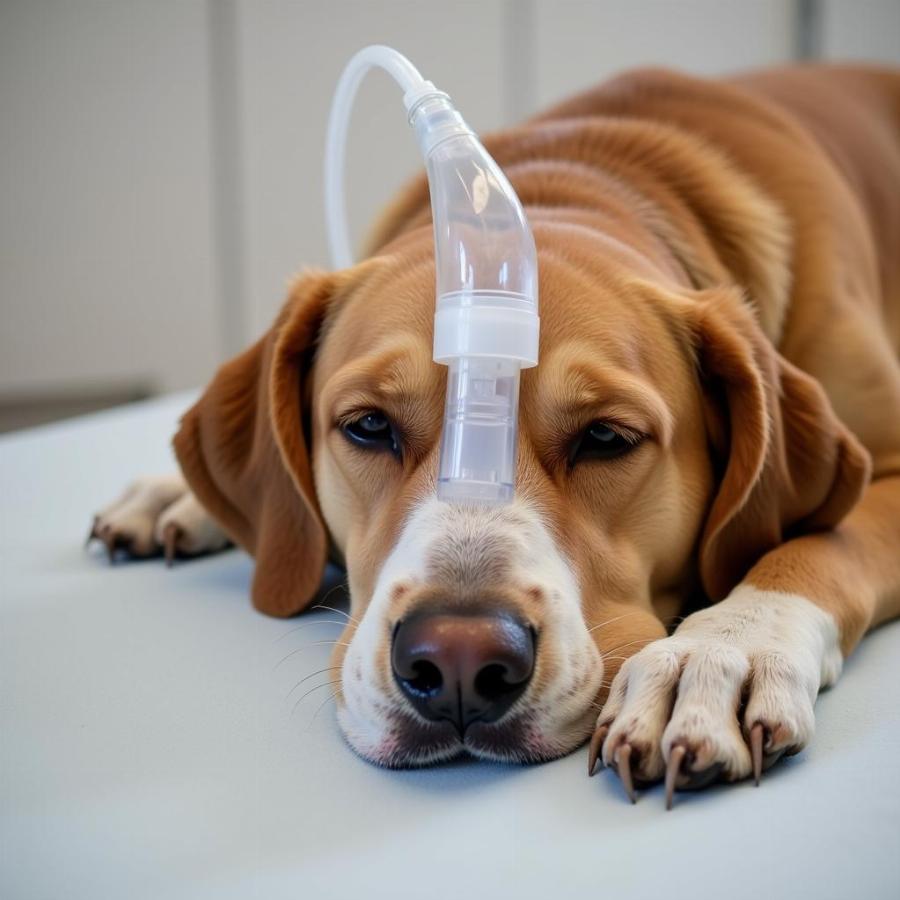Oxygen is essential for life, and that includes our canine companions. Just like us, dogs need a constant supply of oxygen to keep their bodies functioning properly. While we don’t often think about it, understanding when a dog might need supplemental oxygen and how it’s administered can be crucial in emergency situations and for managing certain health conditions. This article will explore the importance of oxygen for dogs, signs of oxygen deficiency, and various ways to provide oxygen support.
When Do Dogs Need Supplemental Oxygen?
Several situations can lead to a dog requiring supplemental oxygen. These include:
- Respiratory Distress: Conditions like pneumonia, asthma, and bronchitis can impair a dog’s ability to breathe effectively, leading to low oxygen levels.
- Trauma: Injuries to the chest, lungs, or airways can disrupt normal breathing and necessitate oxygen therapy.
- Heart Conditions: Heart problems can reduce the efficiency of oxygen circulation throughout the body.
- Anesthesia: During and after surgery, supplemental oxygen is often provided to ensure adequate oxygenation.
- Heatstroke: Severe heatstroke can compromise respiratory function and require oxygen support.
- Carbon Monoxide Poisoning: Exposure to carbon monoxide can displace oxygen in the blood, requiring immediate oxygen therapy.
- Altitude Sickness: Similar to humans, dogs can experience altitude sickness, which can lead to difficulty breathing and necessitate oxygen. This is similar to how do dogs get altitude sickness can affect them.
 Dog Receiving Oxygen Therapy
Dog Receiving Oxygen Therapy
Recognizing Low Oxygen Levels in Dogs
How can you tell if your dog isn’t getting enough oxygen? Look out for these signs:
- Rapid Breathing (Tachypnea)
- Labored Breathing (Dyspnea)
- Blue or Gray Gums (Cyanosis)
- Weakness and Lethargy
- Collapse
- Increased Heart Rate
If you notice any of these signs, immediate veterinary attention is crucial.
How is Oxygen Administered to Dogs?
There are several ways to administer oxygen to dogs:
- Oxygen Cage: Provides a controlled oxygen environment.
- Oxygen Mask: Delivers oxygen directly to the dog’s nose and mouth.
- Nasal Cannula: Small tubes inserted into the nostrils for continuous oxygen flow. This is also a treatment option for pulmonary hypertension dogs.
- Flow-By Oxygen: Holding an oxygen source near the dog’s nose. This method is generally used in emergencies before more sophisticated methods can be implemented.
What is the ideal oxygen flow rate for dogs?
The appropriate oxygen flow rate for a dog depends on its size, condition, and the method of administration. A veterinarian will determine the correct flow rate based on these factors.
Can I administer oxygen to my dog at home?
While it’s possible to administer oxygen at home with veterinary guidance and the appropriate equipment, it’s important to understand the risks and benefits. Improper administration can be harmful. Always consult with your veterinarian before attempting home oxygen therapy. This is just as important as understanding proper deramaxx dosage for dogs.
Oxygen Toxicity in Dogs
While essential, too much oxygen can also be harmful. Oxygen toxicity can damage the lungs and other organs. This is why carefully monitoring oxygen levels and following veterinary instructions is crucial when administering supplemental oxygen.
Maintaining Respiratory Health in Dogs
Maintaining your dog’s overall health can help prevent respiratory issues. This includes regular exercise, a healthy diet, avoiding exposure to toxins like smoke and pollutants, and keeping up with vaccinations.
“Ensuring adequate oxygenation is paramount in treating many canine conditions,” says Dr. Emily Carter, DVM, a leading veterinary specialist in respiratory care. “Prompt diagnosis and appropriate oxygen therapy can be life-saving.”
“Early intervention is key when it comes to respiratory issues in dogs,” adds Dr. Robert Miller, DVM, a board-certified veterinary internal medicine specialist. “Recognizing the signs of respiratory distress and seeking immediate veterinary care can significantly improve outcomes.”
Conclusion
Oxygen is vital for our dogs’ well-being. Understanding the signs of oxygen deficiency and the methods of administering supplemental oxygen can be invaluable in ensuring their health and safety. Always consult with your veterinarian for any concerns about your dog’s respiratory health.
FAQ:
- What are the common signs of low oxygen in dogs? Rapid breathing, blue gums, weakness, and collapse.
- What are the different ways to give oxygen to a dog? Oxygen cages, masks, nasal cannulas, and flow-by oxygen.
- Can I give my dog oxygen at home? Only under veterinary supervision with proper equipment.
- What is oxygen toxicity? A condition caused by excessive oxygen intake, potentially damaging the lungs.
- How can I prevent respiratory problems in my dog? Through regular exercise, a healthy diet, and avoiding exposure to toxins.
- What should I do if I suspect my dog isn’t getting enough oxygen? Seek immediate veterinary attention.
- Is oxygen therapy painful for dogs? Generally, it is not painful when administered correctly.
For further information regarding dog health, you can also explore our articles on can dogs have apricots and orajel for dogs.
Beaut Dogs is your trusted source for comprehensive information on all aspects of dog care, offering expert advice on everything from breed selection to health and nutrition. For any concerns or specific questions about oxygen therapy for your dog, please contact us at Email: [email protected] for detailed and accurate guidance. Visit https://beautdogs.com for a wealth of resources to help you care for your canine companion.